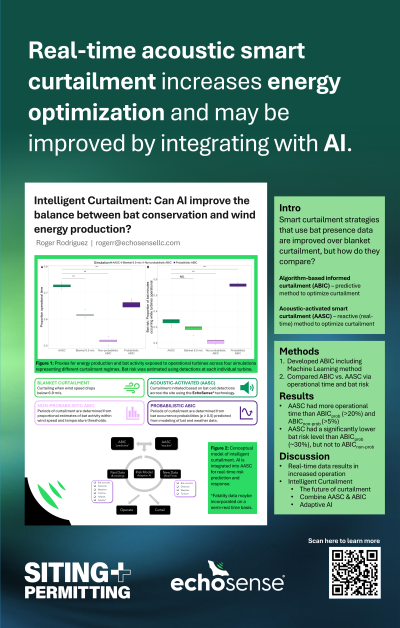Intelligent Curtailment: Can AI improve the balance between bat conservation and wind energy production?
Tuesday, April 15, 2025
5:00 PM - 6:00 PM PT
Location: Regency Ballroom


Roger Rodriguez, MS
Bat Biologist/Principal Consultant
EchoSense LLC, New York
Poster Presenter(s)
Artificial intelligence (AI) has been applied in ecology to understand complex patterns in wildlife occurrence, behavior, and biodiversity, as well as being explored to improve efficient operation of wind energy systems. Thus, AI methods may be beneficial in helping to address the foremost issue of wind energy impacts on bat populations by remedying the tradeoff between bat conservation and renewable energy production. Enhanced curtailment strategies, such as real-time acoustic-activated smart curtailment (AASC), have demonstrated improved efficiency in energy generation while providing similar reduction in bat fatalities as the standard curtailment approach based primarily on low wind speed (i.e., blanket curtailment). Similarly, research is ongoing to understand the effectiveness of algorithm-based informed curtailment (ABIC) in these respects. Nevertheless, both methods have differing strengths, that is, while ABIC methods estimate a period of likely bat presence, these methods may still result in curtailing during periods when bats may not occur in the rotor swept area and/or operate turbines when bats are present, because these methods are only predictive. Alternatively, AASC methods respond to real-time bat activity immediately but represent a more reactive approach which lacks predictive power. In this presentation, we will explore the integration of these two methods into a new paradigm known as ‘intelligent curtailment.’ This approach employs adaptive AI algorithms to analyze real-time data on bat activity, turbine operations, and environmental conditions. By doing so, it can instantly assess the risk to bats and power output, so that energy production is optimized under a project specific bat risk threshold. These innovative AI techniques can be essential for enhancing energy production efficiency, especially as more bat species are listed under federal and state regulations, leading to increased curtailment of wind projects.
